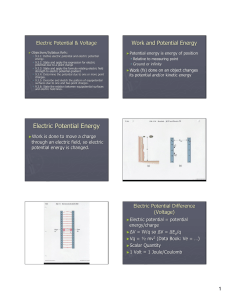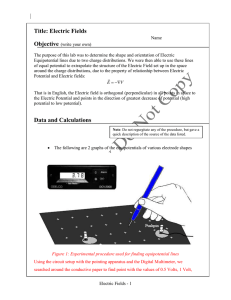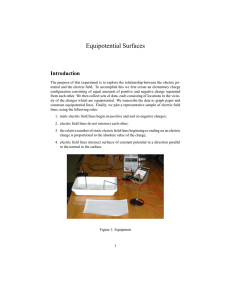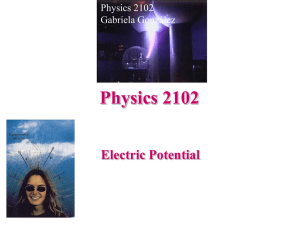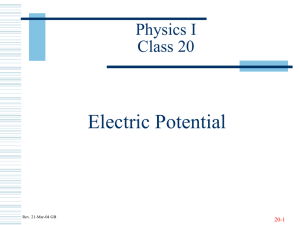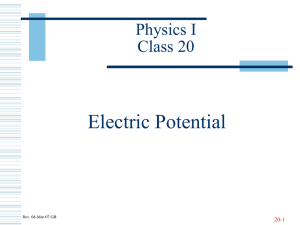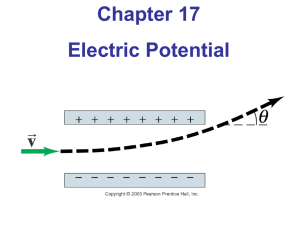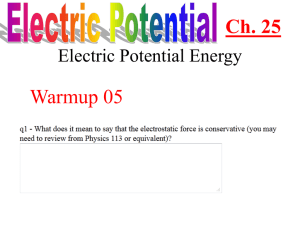Ch 17: Electric Potential
advertisement
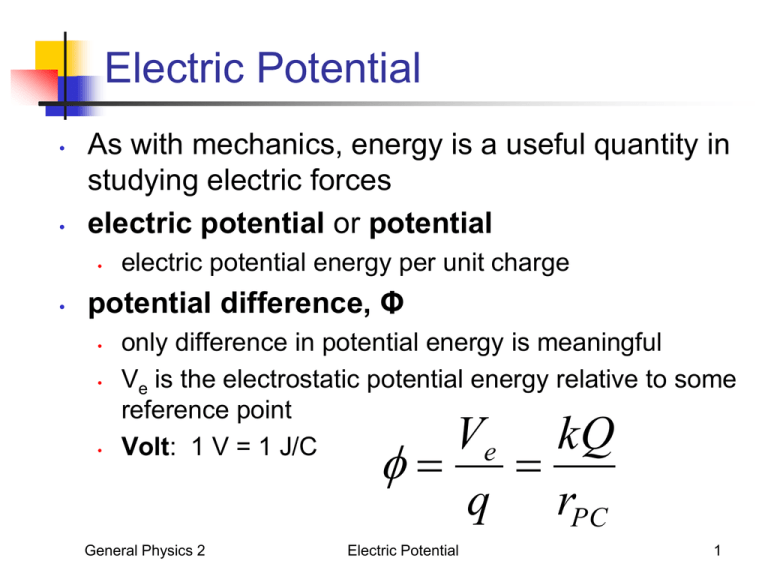
Electric Potential • • As with mechanics, energy is a useful quantity in studying electric forces electric potential or potential • • electric potential energy per unit charge potential difference, Φ • • • only difference in potential energy is meaningful Ve is the electrostatic potential energy relative to some reference point Volt: 1 V = 1 J/C e General Physics 2 V kQ q rPC Electric Potential 1 Analogy to Gravitational PE Gravitation PE depends on mass Electric potential energy depends on charge Φb General Physics 2 Electric Potential Φab Φa 2 Electric Potential of Point Charge • Set V=0 at a distance of infinity General Physics 2 Electric Potential 3 Electric Potential of Multiple Charged Objects • Superposition principle 1 2 3 ... N N kq1 kq2 kq3 kqN kqi ... rP1 rP 2 rP 3 rPN i1 rPi General Physics 2 Electric Potential 4 Electric Potential General Physics 2 Electric Potential 5 Equipotential Lines • • connect points in space at same potential equipotential surface is perpendicular to electric field lines General Physics 2 Electric Potential 6 Electric Field & Equipotential Lines • Draw field lines and equipotential lines for the following charge distributions - General Physics 2 Electric Potential 7 Electric Field & Equipotential Lines • Draw field lines and equipotential lines for the following charge distributions + General Physics 2 Electric Potential 8 Relating Electric Field to Potential • The change in electrical potential for a small displacement in a static electric field r r d E dr E x x, y,z x E x, y,z E y x, y,z y E x, y,z z z General Physics 2 Electric Potential 9 Electrostatic Potential & PE • When dealing with discrete point charges: kq1q2 Ve r kq r Ve and Φ are scalars General Physics 2 F and E are vectors Electric Potential 10 Electric Potential Think of analogy with gravitational PE, where object with positive PE will fall if released. Here, p+ has high PE when near + plate and will “fall” toward negative plate when released Think of + charge when wondering if something is high or low potential + charges move from high to low potential Electric Potential low PE High PE - - Unlike mass, charge can be + or -. Thus, PE depends on the sign of the charge. For example, an e- will have high PE when near the - plate and will “fall” toward the + plate when released - charges move from low to high potential Capacitance • a capacitor stores electric charge General Physics 2 Capacitors 13 Properties of Capacitors • Capacitance, C • • • Q=CV Farad (F) = Coulomb / Volt C depends on size, shape, relative position of parallel plates (and material that separates them) permittivity of free space = 2/(N m2) 8.85 General x 10-12 C Physics 2 surface area per plate Capacitors separation between plates 14 Electron Volt, a Unit of Energy • electron volt (eV) • • • Joule is very large for dealing w/electrons, atoms and molecules eV is energy required to move 1 e- through a potential difference of 1V 1 eV = qe V = (1.6 x 10-19 C)(1.0 V) 1 eV = 1.6 x 10-19 J General Physics 2 Electric Potential 16 Sign of Electric PE • • PE = 0 at infinity Did you have to do work to bring charges from infinity? • yes -> charges have positive PE Example: - • - no -> charges have negative PE Example: - General Physics 2 + Electric Potential 17 ConcepTest 1. 2. 3. positive negative zero ConcepTest Plug & Chug • How much work does the electric field do in moving a -7.7C charge from the ground to a point whose potential is +55 V higher? General Physics 2 Electric Potential 20 Think-Pair-Share • How much kinetic energy will an electron gain (in joules and eV) if it accelerates through a potential difference of 23,000 V in a TV picture tube? What is its final velocity? General Physics 2 Electric Potential 21 Electric Potential & Electric Field • For a uniform electric field uniform electric field General Physics 2 Electric Potential 22 Electric Field & Equipotential Lines • Draw field lines and equipotential lines for the following charge distributions - General Physics 2 - Electric Potential 23 Which set has a positive potential energy? Which set has a negative potential energy? Plug & Chug • What is the electric potential 15.0 cm from a 4.00 x 10-6 C point charge? General Physics 2 Electric Potential 26 Think-Pair-Share • What is the potential at point A, taking V=0 at a great distance? General Physics 2 Electric Potential 27
